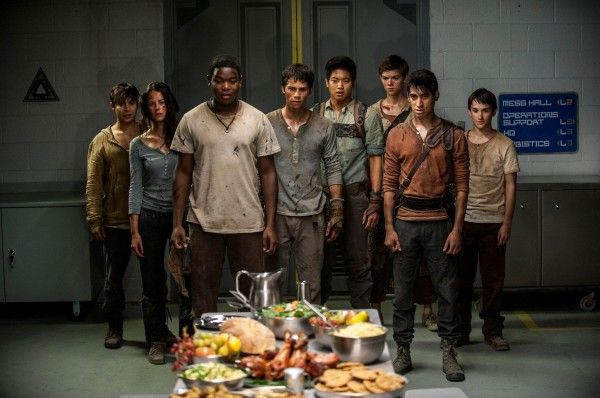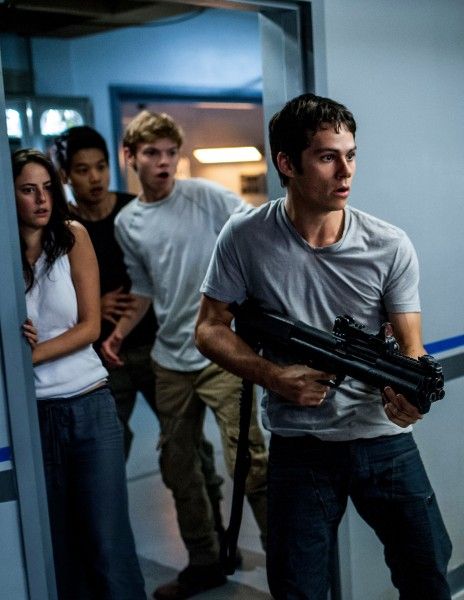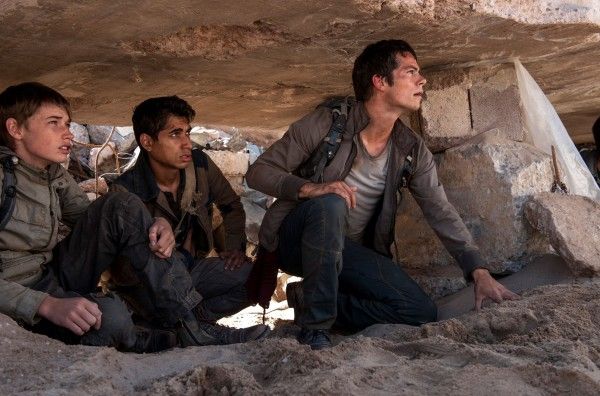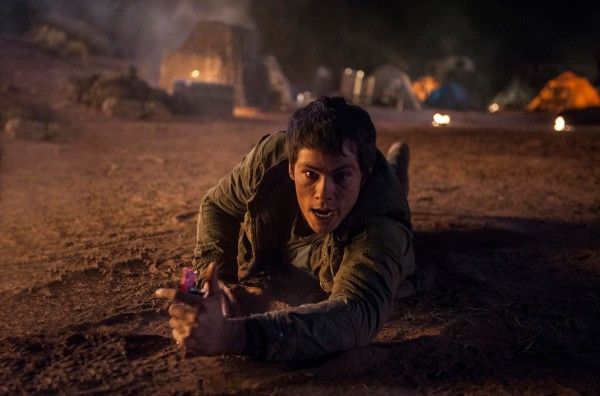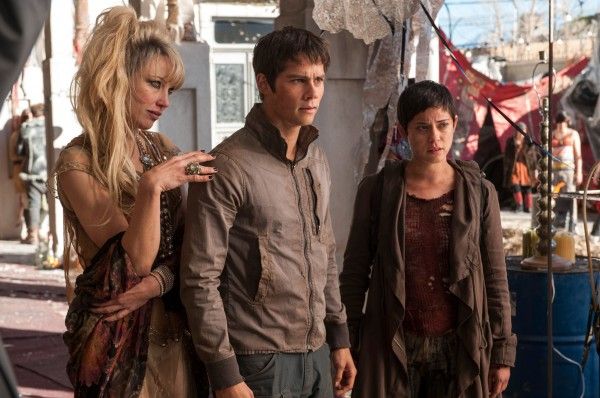The first Maze Runner movie is especially faithful to the source material. There are differences here and there like the absence of the beetle blades and the omission of Thomas (Dylan O’Brien) and Teresa’s (Kaya Scodelario) telepathy, but for the most part, the movie hits all the same story beats as James Dashner’s book. However, that’s definitely not the case with Maze Runner: The Scorch Trials.
In the sequel, the surviving Gladers are out of the confines of the Maze and head into what’s left of the real world. It’s a significantly bigger story with more locations, characters and a far more robust view of Wicked’s agenda. It isn’t surprising that director Wes Ball and writer T.S. Nowlin opted to pare things down, but what I didn’t see coming was how much creative license they’d take when painting the big picture.
Warning: This article contains spoilers for both The Scorch Trials the book and Maze Runner: The Scorch Trials the movie.
Fewer Gladers
We knew we were getting less Gladers in the sequel because so few made it out of the Maze in the first movie. There’s Thomas, Minho (Ki Hong Lee), Newt (Thomas Brodie-Sangster), Frypan (Dexter Darden), Winston (Alexander Flores), Teresa and Jack (Bryce Romero). Jack is basically the equivalent of a prop because it looks as though his death scene never made it into the final cut. Check out the trailer at the 1:45 mark. I’m not sure if that’s Jack that gets knocked over the edge after some Cranks come crashing through the glass, but that’s definitely him hanging on for dear life in the subsequent shot. On top of that, if you caught one of the first images ever released from The Scorch Trials, there’s another Glader who never made it into the final film at all. The tasty meal scene is nowhere to be found and neither is that guy standing behind Teresa on the far left either.
There’s more than enough going on in The Scorch Trials, so it was a smart move to keep the focus on fewer Gladers. Yes, I would have liked to see what happened to Jack simply because the scene plays so well in the promos, but by cutting out his big moment, Winston’s demise becomes far more meaningful.
They’re Not Infected
In the book, before the Gladers head out into the Scorch, “Rat Man” (Janson in the movie) warns them that they’ve been infected with The Flare and that the only way for them to secure the cure is by completing Phase 2 and making it to the safe haven. The movie is an action-packed thrill, but it doesn’t have the same sense of urgency as the book because Thomas and co. aren’t racing for their lives to get the cure.
This also sparks some serious structural issues. Before they begin their journey in the book, “Rat Man” very clearly specifies the details of their mission so whether they’re being attacked by Cranks or running for their lives in a storm, you always know where they’re going and what they’re fighting for. In the movie, that isn’t always clear and their journey can feel a bit arbitrary and directionless.
Less about the Experiment
There are certain story elements that were cut from the film that I miss simply because I liked them, but the omission of the whole concept of “Phase Two” is a nearly devastating adaptation flaw. In the book, Rat Man explains that the Scorch is Phase Two of the Trials. He tells them exactly what they need to do to complete them and, boom, they’re off. Not only does the whole concept of “Phase Two” give Scorch Trials the book clarity and structure, but it also gives what’s happening to the Gladers meaning. There’s no mention of “Phase Two” in the movie and it doesn’t seem as though Wicked is taking the same approach to finding a cure at all. Rather than send those who survived the Maze out into the Scorch to map their behavior to develop a cure, the movie version of Wicked has Maze survivors strung up chemistry experiment-style. If that’s the way they want to find a cure, sure. I can buy that. But the change will undoubtedly affect what goes down in The Death Cure big time. It could work, but hopefully this change still leaves room for Thomas’ conflicted feelings about the experiment. On the one hand, it seems as though Wicked is up to no good, but if the surviving Gladers do really hold the key to the cure and this is the only way for them to extract it, how could Thomas say no to saving the world?
The lack of focus in regards to the experiment also almost completely devalues the addition of Aris (Jacob Lofland), Sonya (Katherine McNamara) and Harriet (Nathalie Emmanuel). In the book, there’s only Group A, the survivors from Thomas’ maze, and Group B, the survivors from Aris’ maze. By introducing the idea that there are many mazes, it makes Group B feel less important and obliterates the idea that Group A could affect the fate of Group B and vice versa.
More Teresa
I’m still somewhat obsessed with the first Maze Runner movie and have a habit of watching it over and over again, but still to this day my biggest issue with it is how underdeveloped Teresa is. She’s basically a plot device. She shows up to trigger the ending, but then she just follows Thomas around and never really contributes anything significant during the big escape. In Scorch Trials, however, Teresa gets a major upgrade. Not only is she in the movie far more than she’s in the book, but the new material she gets actually turns her into a layered character. Scodelario deserves some major credit for how well she walks the line between supporting her friends and having a mind of her own. When she makes the choice to betray Thomas, Newt and Minho and take off with Janson (Aiden Gillen) and Ava Paige (Patricia Clarkson) at the tail end of the film, it comes as a shock but also feels motivated and earned. There’s no doubt that what Ball, Nowlin and Scodelario have done with Teresa this time around will lead to some especially rich material in The Death Cure.
No Metal Balls or Bulb Monsters
You may know that I love horror movies, so is it a surprise that I wanted to see some skull-crushing gore? I had a feeling the bulb monsters would bite the dust because, really, did they serve any purpose in the book besides being cool creatures to pit the Gladers against during the big finish? The scene with the metal balls, however, really could have been a terrifying introduction to the threats that await the Gladers in the Scorch. In the book, the scene has an absolutely brilliant horror-like vibe, with the Gladers essentially blind and completely helpless in a dark hallway as these metal balls eerily roll around before striking. You don’t get many moments in a hero’s journey when he or she encounters something that feels unbeatable, but that’s exactly what these things are and they force the Gladers out into the Scorch with an incredible amount of momentum.
Conclusion
First and foremost, I very much enjoyed Maze Runner: The Scorch Trials. I’ve got a habit of watching the first film over and over, and there’s no doubt that the same will happen with Scorch Trials when it hits DVD and Blu-ray. But, as far as the story goes, there’s no denying that the movie is all over the place, lacks clarity and also doesn’t have much of a build. However, Ball gets away with it for a number of reasons. First off, he’s a visual pro and can bring the best out of any scene through shot composition alone. The Scorch Trials is also absolutely brimming with strong, dedicated performances and, even though the movie feels disjointed, as far as individual set pieces go, every single one of them is highly entertaining, compelling and well shot. Is this the best possible adaptation of Dashner’s second book? Probably not, but it’s certainly good enough to further prove that Ball is a revelation, make you want to re-watch Scorch Trials and get you pumped for Death Cure as well.


